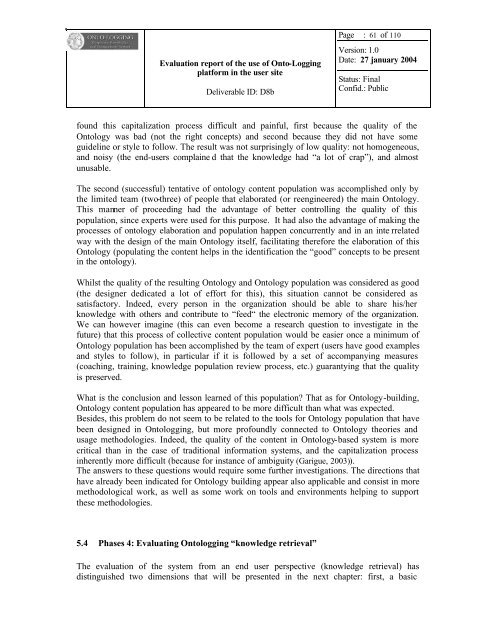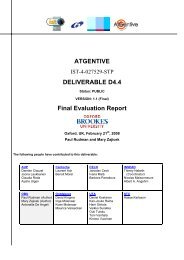pdf 820Kb - INSEAD CALT
pdf 820Kb - INSEAD CALT
pdf 820Kb - INSEAD CALT
Create successful ePaper yourself
Turn your PDF publications into a flip-book with our unique Google optimized e-Paper software.
Evaluation report of the use of Onto-Logging<br />
platform in the user site<br />
Deliverable ID: D8b<br />
Page : 61 of 110<br />
Version: 1.0<br />
Date: 27 january 2004<br />
Status: Final<br />
Confid.: Public<br />
found this capitalization process difficult and painful, first because the quality of the<br />
Ontology was bad (not the right concepts) and second because they did not have some<br />
guideline or style to follow. The result was not surprisingly of low quality: not homogeneous,<br />
and noisy (the end-users complaine d that the knowledge had “a lot of crap”), and almost<br />
unusable.<br />
The second (successful) tentative of ontology content population was accomplished only by<br />
the limited team (two-three) of people that elaborated (or reengineered) the main Ontology.<br />
This manner of proceeding had the advantage of better controlling the quality of this<br />
population, since experts were used for this purpose. It had also the advantage of making the<br />
processes of ontology elaboration and population happen concurrently and in an inte rrelated<br />
way with the design of the main Ontology itself, facilitating therefore the elaboration of this<br />
Ontology (populating the content helps in the identification the “good” concepts to be present<br />
in the ontology).<br />
Whilst the quality of the resulting Ontology and Ontology population was considered as good<br />
(the designer dedicated a lot of effort for this), this situation cannot be considered as<br />
satisfactory. Indeed, every person in the organization should be able to share his/her<br />
knowledge with others and contribute to “feed“ the electronic memory of the organization.<br />
We can however imagine (this can even become a research question to investigate in the<br />
future) that this process of collective content population would be easier once a minimum of<br />
Ontology population has been accomplished by the team of expert (users have good examples<br />
and styles to follow), in particular if it is followed by a set of accompanying measures<br />
(coaching, training, knowledge population review process, etc.) guarantying that the quality<br />
is preserved.<br />
What is the conclusion and lesson learned of this population? That as for Ontology-building,<br />
Ontology content population has appeared to be more difficult than what was expected.<br />
Besides, this problem do not seem to be related to the tools for Ontology population that have<br />
been designed in Ontologging, but more profoundly connected to Ontology theories and<br />
usage methodologies. Indeed, the quality of the content in Ontology-based system is more<br />
critical than in the case of traditional information systems, and the capitalization process<br />
inherently more difficult (because for instance of ambiguity (Garigue, 2003)).<br />
The answers to these questions would require some further investigations. The directions that<br />
have already been indicated for Ontology building appear also applicable and consist in more<br />
methodological work, as well as some work on tools and environments helping to support<br />
these methodologies.<br />
5.4 Phases 4: Evaluating Ontologging “knowledge retrieval”<br />
The evaluation of the system from an end user perspective (knowledge retrieval) has<br />
distinguished two dimensions that will be presented in the next chapter: first, a basic
















